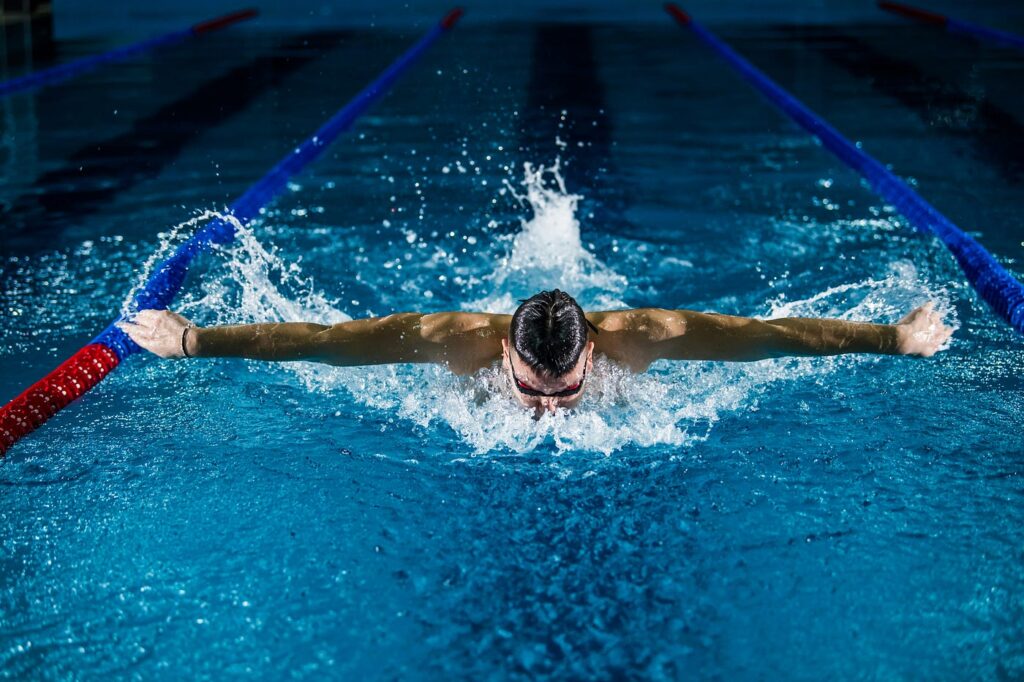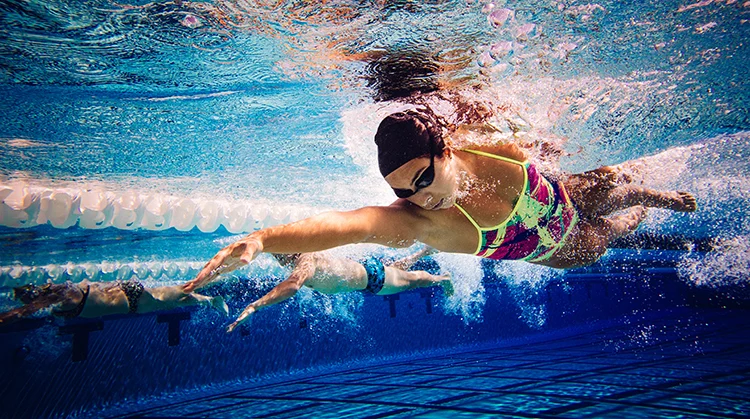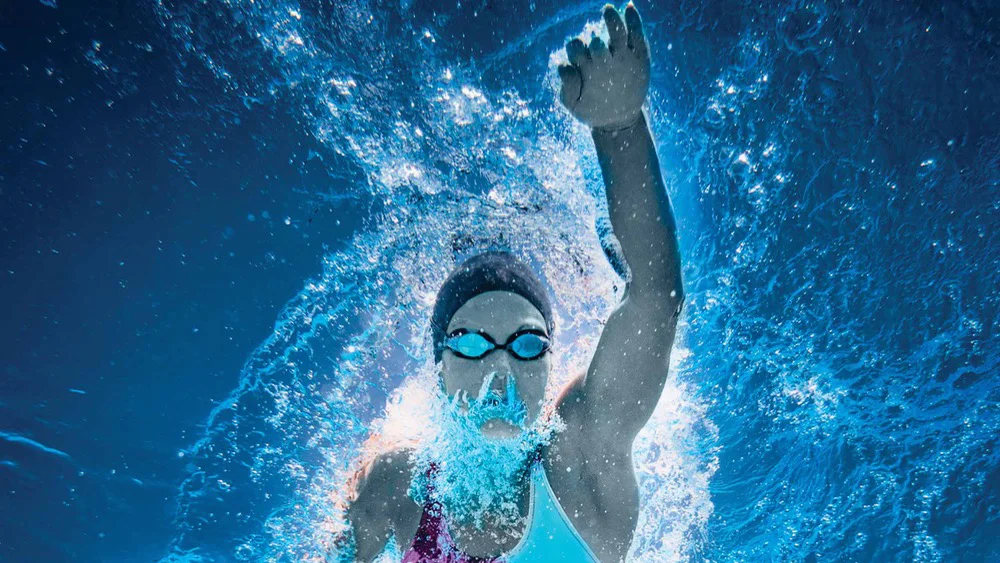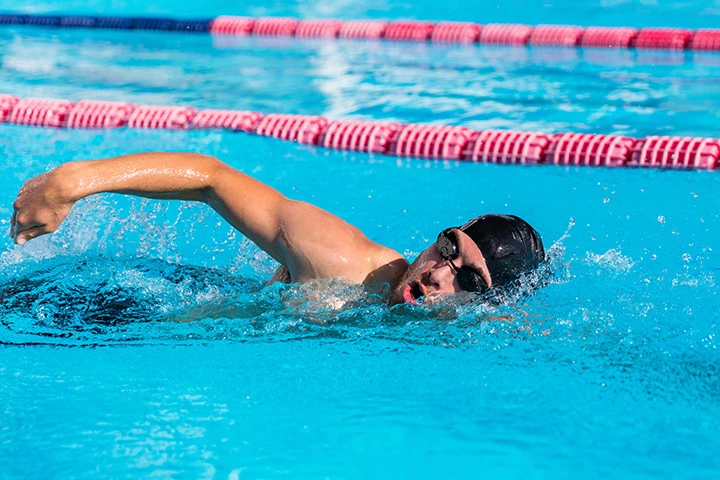The article ‘Breathe Right, Swim Faster: Freestyle Breathing Drills for Improved Performance’ dives into the world of competitive swimming, focusing on the importance of proper breathing techniques in freestyle swimming. It outlines essential drills and practices that can enhance a swimmer’s performance by improving oxygen efficiency, speed, and overall technique. The article also touches on the significance of team dynamics and preparation for competitive swimming, ensuring swimmers are not only technically proficient but also mentally prepared for the challenges of the sport.
Key Takeaways
- Mastering freestyle fundamentals is crucial for passing the swim test and advancing in swim levels.
- Synchronized breathing and developing a smooth rhythm are key to increasing oxygen efficiency during freestyle swimming.
- Progressive speed drills and kick sets are effective in building speed and fine-tuning stroke technique.
- Team dynamics, including circle swimming and teambuilding exercises, play a significant role in a swimmer’s training regimen.
- Preparation for competitive swimming extends beyond the pool, encompassing diving techniques, proper warm-ups and cool-downs, and goal setting.
Mastering the Basics: Freestyle Fundamentals
Nailing the Swim Test: A Primer
Before you can glide through the water like a pro, you’ve got to ace the swim test. It’s your ticket to the next level of swimming prowess, where endurance, technique, and speed become your new best friends. Passing the swim test is your first victory lap; it’s a rite of passage that consists of a 25-yard freestyle and a 25-yard backstroke. But it’s not just about getting from one end of the pool to the other; it’s about doing it with style and efficiency.

To get you prepped, here’s a quick rundown of what to expect:
- A 25-yard freestyle swim that’s all about smooth strokes and steady breathing.
- A 25-yard backstroke that tests your ability to stay streamlined and relaxed.
Don’t sweat it if you’re not Michael Phelps right out of the gate. This is about learning the ropes, making friends, and soaking up the joys of swimming.
Once you’ve got the swim test in the bag, you’ll be ready to dive into the world of competitive swimming. It’s a splashy mix of kick sets, swim sets, and the all-important circle swimming. And let’s not forget the fun stuff like cannonball jumps and cool-downs. It’s a journey that’s as much about sportsmanship and teambuilding as it is about lap times.
The Art of Streamlined Swimming
Streamlining is the secret sauce of swimming freestyle technique for beginners. It’s all about reducing drag and gliding through the water like a human torpedo. When in streamline, squeeze your biceps to your ears and keep your body as straight as an arrow. This tip isn’t just for newbies; even Michael Phelps freestyle technique emphasizes a tight streamline.
Freestyle swimming tips for beginners often overlook the importance of the kick in freestyle swimming. But here’s the deal: a consistent, fluttery kick is your engine. It keeps you balanced and propels you forward. So, let’s break down the freestyle swimming steps into a simple list:
- Keep your head down and look straight at the bottom of the pool.
- Rotate your body along the axis from head to toe with each stroke.
- Use a relaxed but firm kick, with your legs close together.
- Practice how to breathe in freestyle swim by turning your head to the side just enough to catch a breath without lifting it out of the water.
Remember, the goal is to move through the water efficiently, not to fight against it. Keep practicing, and you’ll find your rhythm, making every stroke count.
Building a Solid Freestyle Foundation
Diving into freestyle for beginners, it’s crucial to establish a strong foundation. This means focusing on technique before speed. A balanced kick is the cornerstone of a solid freestyle foundation. By perfecting your kick, you ensure that your freestyle is not only efficient but also sustainable over long distances.

To build this foundation, consider incorporating specific drills into your routine. For example, a drill highlighted by U.S. Masters Swimming emphasizes the importance of developing the muscles in the back of your leg, particularly your hamstrings. This will reinforce a more balanced kicking action.
Here’s a simple drill sequence to get you started:
- Start with a flutter kick on your back to focus on hamstring engagement.
- Progress to side kicking drills to promote body alignment.
- Integrate full stroke swimming, concentrating on maintaining a consistent kick.
Consistency is key. Regular practice of these drills will not only improve your kick but also your overall freestyle technique.
Breath Control: Techniques to Boost Your Oxygen Efficiency
Synchronized Breathing: Timing is Everything
Getting your breathing in sync with your strokes can feel like patting your head and rubbing your belly at the same time. But once you get the hang of it, it’s a game-changer for your freestyle. Synchronize the beginning of the stroke with your rotation. This means as one arm pulls through the water, your body rotates, and you take a breath. It’s a smooth, continuous motion that keeps your momentum going strong.
Here’s a simple drill to practice: Take a stroke with your right arm, rotate your body to the right, and breathe. Then, repeat on the left. Keep alternating, focusing on making each movement deliberate and controlled. The goal is to minimize drag and maintain a steady pace.
Consistency is key. Aim for a rhythmic pattern where your breath seamlessly flows with each stroke. This isn’t just about gasping for air; it’s about integrating your breath with your body’s natural movement in the water.
Remember, it’s not about speed at first. It’s about getting the timing down pat. Once you’ve mastered the rhythm, the speed will follow.
Drills for Developing a Smooth Breathing Rhythm
Getting your breathing right can feel like trying to pat your head and rub your belly at the same time. But with a few key drills, you’ll be inhaling and exhaling like a pro in no time. Start with the basics: focus on breathing out underwater so you’re ready to take a fresh breath as you turn your head. It’s all about that smooth rhythm.
Consistency is your best friend here. Aim to breathe every three strokes to maintain a balanced oxygen flow and prevent overexertion on one side.
To really nail this skill, try incorporating these drills into your routine:
- Single-Arm Freestyle: Swim with one arm extended forward, and breathe to the side of the stroking arm. This drill emphasizes the importance of timing your breath with your stroke.
- Catch-Up Drill: Alternate arms in a freestyle stroke, but only start the next stroke once the other hand has ‘caught up’. This gives you more time to focus on your breathing pattern.
- Zipper Drill: Pretend to zip up an imaginary zipper along your side each time you take a stroke. This encourages high elbow recovery and helps you time your breath as your hand passes your hip.
Remember, the goal is to integrate breathing so seamlessly into your stroke that it becomes second nature. With practice, you’ll be swimming more efficiently and, as a result, faster.
Read more: Boost Your Speed: Top Freestyle Kick Drills for Improving Your Swim
Common Breathing Mistakes and How to Fix Them
Ever felt like you’re gasping for air with every stroke? You’re not alone. Breathing too late is a classic blunder. When your head turns for air, your body should be midway through the pull phase, not at the end. This timing mismatch can throw off your whole rhythm.

Another hiccup swimmers face is holding their breath underwater. Instead, try to exhale steadily when your face is submerged. This way, you’re ready to inhale fresh air as soon as you turn your head.
Here’s a quick fix list to keep your lungs happy and your strokes smooth:
- Turn your head early in the pull phase.
- Exhale underwater, don’t hold your breath.
- Practice bilateral breathing to balance your stroke.
- Avoid lifting your head too high; keep one goggle submerged.
Consistency is key. Drill these corrections into your muscle memory, and watch your freestyle flourish.
Speed Through Skill: Drills to Enhance Your Freestyle
From Slow to Pro: Progressive Speed Drills
Progressive speed drills are the secret sauce to shaving seconds off your lap times. Start with longer pulls at a moderate effort, around 70% intensity, and gradually ramp up. It’s like a crescendo in music; each repeat should build in intensity, pushing you just a bit more than the last.
By the end of your set, you should be hitting that sweet spot of 85% effort, where speed meets endurance. This is where the magic happens, and you start to feel like you’re flying through the water.
Remember, consistency is key. Stick to a structured plan, and you’ll see the difference. Here’s a simple 4-week outline to get you started:
- Week 1: Focus on technique, keep the intensity moderate.
- Week 2: Increase the intensity of your repeats slightly.
- Week 3: Introduce more speed work, aim for 80% effort.
- Week 4: Push the limits, aim for 85% effort on shorter repeats.
Track your progress and adjust as needed. With each session, you’re building not just speed, but also confidence and the mental toughness to compete.
Fine-Tuning Your Stroke for Maximum Efficiency
Alright, you’ve got the basics down and you’re ready to fine-tune that stroke to slice through the water like a hot knife through butter. Freestyle swimming with a kickboard is a fantastic way to focus on your arm movements. Here’s a drill that’s a staple for swimmers at any level: Perform two or three freestyle arm strokes (pulls) while holding onto the kickboard. This helps isolate your upper body, allowing you to concentrate on perfecting each pull.
When it comes to freestyle drills for beginners, simplicity is key. Start with drills that emphasize one aspect of your stroke at a time. This way, you can make adjustments without feeling overwhelmed.
Drills for breathing in freestyle are equally important. You want to nail that rhythmic breath without throwing off your flow. Try this sequence:
- Inhale quickly during the arm recovery phase.
- Exhale steadily underwater as your arms pull.
- Repeat and focus on maintaining a consistent breathing pattern.
Remember, the goal is to become more efficient with every stroke, not just faster. Keep practicing, and you’ll see the difference in no time!
The Role of Kick Sets in Building Speed
When it comes to slicing through the water with greater speed, freestyle kick drills are a swimmer’s secret weapon. These drills are designed to strengthen the legs, improve kick technique, and ultimately contribute to a faster freestyle stroke.
Incorporating kick sets into your routine is not just about endurance; it’s about developing a powerful motor below the surface that propels you forward with each stroke. Here’s a simple breakdown of how kick sets can ramp up your speed:
- Strength: Building leg muscles for more forceful kicks.
- Endurance: Increasing the ability to maintain a strong kick throughout your swim.
- Technique: Refining the flutter kick to minimize drag and maximize propulsion.
- Rhythm: Establishing a consistent kick pattern that syncs with your stroke.
Kick sets are not just a workout segment; they’re a crucial part of a swimmer’s journey to becoming faster and more efficient in the water.
Remember, the key to benefiting from kick sets is regular practice and progressive difficulty. Start with shorter distances and gradually increase as your strength and stamina improve. And don’t forget to mix it up with different speeds and intervals to challenge your muscles and keep your workouts fresh.
The Social Swimmer: Integrating Team Dynamics in Training
Circle Swimming: Keeping it Friendly and Efficient
Circle swimming isn’t just about avoiding head-on collisions; it’s a social dance in the water that keeps things moving smoothly. When everyone knows the steps, the pool becomes a harmonious place for all. It’s essential for managing multiple swimmers during practice, ensuring everyone gets the workout they need without the chaos.
- Always stick to the right side of the lane.
- Overtake only at the wall, and signal your intent with a gentle tap on the swimmer’s foot.
- Maintain a consistent pace to avoid bunching up.
- Communicate with your lane mates to set the flow before jumping in.
Circle swimming, when done right, can be a great way to make new friends and learn more about swimming in a relaxed environment. It’s a chance to exercise not just your body, but also your social skills and sportsmanship.
Remember, the key to circle swimming is awareness and consideration. Keep an eye out for your fellow swimmers, and you’ll find that the rhythm of the pool is something you can all enjoy together.
Teambuilding Exercises for Aspiring Swimmers
Swimming is as much a team sport as it is an individual challenge. Teambuilding exercises are crucial for fostering a sense of unity and camaraderie among swimmers. A popular way to inject some fun into the grind of training is through games that not only strengthen the team bond but also enhance swimming skills. For instance, ‘Friday FunDay’ can be a day dedicated to games that improve team morale and build community, all while honing swimming techniques.
Engaging in team activities outside of the usual swim sets can lead to a more cohesive unit. These exercises can range from relays that emphasize teamwork to problem-solving activities in the water.
Here’s a quick rundown of some teambuilding exercises:
- Relay races with a twist, like medley swims or using kickboards
- Treasure hunts for underwater objects to encourage breath control
- Tug-of-war, pool style, with a rope and floating devices
- ‘Sharks and Minnows’ to boost speed and agility
- Partnered swim drills to work on pacing and synchronization
Remember, the goal is to balance serious training with light-hearted competition. By doing so, you’ll see not just stronger swimmers, but a stronger swim community.
Creating a Supportive Swim Community
A supportive swim community is not just about churning through the water; it’s about fostering an environment where every member feels valued and empowered. Body Empowerment is a concept that resonates deeply within such communities, encouraging swimmers to embrace their individual strengths and contribute to the team’s success.

Here’s how you can cultivate this supportive atmosphere:
- Encourage open communication and regular feedback among team members.
- Organize social events like movie nights or obstacle courses to strengthen bonds.
- Implement mentorship programs where experienced swimmers guide newcomers.
- Celebrate individual and team milestones to boost morale and motivation.
In the end, it’s the shared experiences and the collective push towards improvement that truly define a supportive swim community. It’s about more than just the laps; it’s the laughter, the camaraderie, and the shared journey towards personal and team goals.
Beyond the Pool: Prepping for Competitive Success
Diving into Competitive Swimming: What to Expect
Taking the plunge into competitive swimming is an exhilarating step. Expect to refine your technique, build endurance, and learn the ropes of swim meets. It’s not just about swimming back and forth; you’ll engage in a variety of activities to enhance your skills and enjoyment of the sport.
From the first splash to the final lap, competitive swimming is a journey of personal growth and team spirit.
Here’s a quick rundown of what you might encounter:
- Swim tests to gauge your readiness
- Drills for each of the four competitive strokes
- Endurance-building practices
- Speed work and goal setting
- Sportsmanship and team-building exercises
Remember, while the schedule may seem intense, it’s designed to be fun and foster a sense of community. Classes typically run on a set schedule, and while attendance is important, it’s okay if you miss a session here and there. The key is consistent effort and a positive attitude!
Warm-Ups and Cool-Downs: The Key to Longevity
Understanding the importance of warm-ups and cool-downs is crucial for any swimmer looking to sustain a long and healthy swimming career. Warm-ups gradually rev up your cardiovascular system, increase blood flow to your muscles, and raise your body temperature, which is essential for peak performance. On the flip side, cool-downs help your body reset to a resting state, clear out lactic acid build-up, and reduce the risk of muscle soreness.
A proper cool-down can be the difference between feeling sore for days or bouncing back quickly for your next swim session.
Here’s a simple cool-down routine to integrate into your training:
- Start with 5 minutes of easy swimming to lower your heart rate.
- Follow with 3 minutes of ‘cannon ball jumps’ to loosen up.
- Finish with 5 minutes of stretching on deck, focusing on your shoulders, hips, and legs.
Setting Goals and Tracking Improvements
After you’ve set your swimming goals and started tracking your progress, it’s time to dive deeper into the metrics that can truly transform your performance. Understanding your SWOLF score is a game-changer. SWOLF, a term combining ‘Swim’ and ‘Golf’, is a measure of swimming efficiency. The lower your SWOLF score, the better. It’s calculated by adding together the number of strokes you take per length of the pool and the time it takes to swim that length.
To get started, simply count your strokes and time your laps. This basic data collection can reveal a lot about your swimming efficiency and areas that need improvement.
Here’s a quick guide to what tracking your SWOLF can do for you:
- Encourage greater efficiency in the water
- Identify stroke weaknesses
- Provide added motivation
- Improve race strategy
By regularly measuring and analyzing your SWOLF score, you can make targeted changes to your technique, leading to faster times and a more enjoyable swimming experience.
Dive into excellence with our comprehensive guides and resources at Swim Time Log. Whether you’re a beginner or a seasoned competitor, our expert advice on techniques, nutrition, and gear will help you achieve your swimming goals. Don’t just dream about success in the pool—prepare for it with our tailored training programs and insider tips. Visit our website now to unlock your full potential and join a community that celebrates every splash towards victory!
Conclusion
As we wrap up our dive into the world of freestyle breathing drills, remember that practice makes perfect. Whether you’re a beginner getting your feet wet or an aspiring competitive swimmer refining your strokes, incorporating these drills into your routine can significantly boost your performance. Embrace the challenge, enjoy the camaraderie of the swim community, and don’t forget to have fun with it! After all, swimming is not just about the speed—it’s about the joy of the sport and the friends you make along the way. Keep splashing, and you’ll find that with each breath and each stroke, you’re not just swimming faster—you’re building a lifetime of memories in the water.
Read more: Making a Splash: An Introduction to Freestyle Swimming for Newbies
AUTHOR
Sang Nguyen
Sang Nguyen is a former national swimmer for Vietnam who has transitioned into coaching. With a passion for fostering a healthy swimming community and connecting like-minded individuals,......Read More
BLOG
Maybe You Are Interested
Good Swim Meet Snacks: What to Eat for Optimal Performance
Good nutrition is crucial for swimmers to maintain energy, recover quickly, and perform at their...
Read More...Optimizing Your Performance: The Best Diet for Swimming Training
Optimizing your performance in swimming is not just about rigorous training; it’s equally crucial to...
Read More...Achieve Peak Performance with This Diet Chart for Swimmers
Whether you’re a novice or an expert swimmer, understanding the right diet is crucial for...
Read More...Eating Like a Champion: Exploring the Diet of Michael Phelps
Michael Phelps, renowned for his Olympic triumphs, has a diet as extraordinary as his swimming...
Read More...Muscle Gain for Swimmers: Tailoring Your Diet for Strength
Swimming is a demanding sport that requires a tailored approach to nutrition to support muscle...
Read More...A Comprehensive Diet Plan To Gain Weight For Swimmers
Swimming is a demanding sport that requires meticulous attention to nutritional needs to optimize performance,...
Read More...